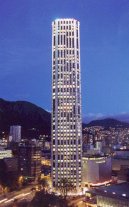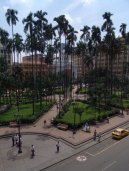| Introduction - Colombia: |
| Location - Colombia: |
| People - Colombia: |
| Government - Colombia: |
| Economy - Colombia: |
Economy overview | Colombias economy has experienced positive growth over the past three years despite a serious armed conflict. The economy continues to improve in part because of austere government budgets, focused efforts to reduce public debt levels, an export-oriented growth strategy, an improved security situation in the country, and high commodity prices. Ongoing economic problems facing President URIBE range from reforming the pension system to reducing high unemployment, and to achieving congressional passage of a fiscal transfers reform; furthermore, new exploration is needed to offset declining oil production. However, the governments economic policy, democratic security strategy, and the signing of a free trade agreement with the US have engendered a growing sense of confidence in the economy, particularly within the business sector. |
|
Gdp purchasing power parity | $374.4 billion (2006 est.) |
|
Gdp official exchange rate | $106.8 billion (2006 est.) |
|
Gdp real growth rate | 6.8% (2006 est.) |
|
Gdp per capita ppp | $8,600 (2006 est.) |
|
Gdp composition by sector | agriculture: 12%
industry: 35.2%
services: 52.7% (2006 est.) |
|
Labor force | 20.81 million (2006 est.) |
|
Labor force by occupation | agriculture: 22.7%
industry: 18.7%
services: 58.5% (2000 est.) |
|
Unemployment rate | 11.1% (2006 est.) |
|
Population below poverty line | 49.2% (2005) |
|
Household income or consumption by percentage share | lowest 10%: 7.9%
highest 10%: 34.3% (2004) |
|
Distribution of family income gini index | 53.8 (2005) |
|
Inflation rate consumer prices | 4.3% (2006 est.) |
|
Investment gross fixed | 22.8% of GDP (2006 est.) |
|
Budget | revenues: $50.7 billion
expenditures: $52.29 billion; including capital expenditures of $NA (2006 est.) |
|
Public debt | 45.3% of GDP (2006 est.) |
|
Agriculture products | coffee, cut flowers, bananas, rice, tobacco, corn, sugarcane, cocoa beans, oilseed, vegetables; forest products; shrimp |
|
Industries | textiles, food processing, oil, clothing and footwear, beverages, chemicals, cement; gold, coal, emeralds |
|
Industrial production growth rate | 5.8% (2006 est.) |
|
Electricity production | 46.93 billion kWh (2004) |
|
Electricity consumption | 42.01 billion kWh (2004) |
|
Electricity exports | 1.682 billion kWh (2004) |
|
Electricity imports | 48 million kWh (2004) |
|
Oil production | 512,400 bbl/day (2005 est.) |
|
Oil consumption | 269,000 bbl/day (2004 est.) |
|
Oil exports | NA bbl/day |
|
Oil imports | NA bbl/day |
|
Oil proved reserves | 1.282 billion bbl (2006 est.) |
|
Natural gas production | 6.18 billion cu m (2004 est.) |
|
Natural gas consumption | 6.18 billion cu m (2004 est.) |
|
Natural gas exports | 0 cu m (2004 est.) |
|
Natural gas imports | 0 cu m (2004 est.) |
|
Natural gas proved reserves | 114.4 billion cu m (1 January 2005 est.) |
|
Current account balance | -$2.219 billion (2006 est.) |
|
Exports | $24.86 billion f.o.b. (2006 est.) |
|
Exports commodities | petroleum, coffee, coal, nickel, emeralds, apparel, bananas, cut flowers |
|
Exports partners | US 35.8%, Venezuela 10.4%, Ecuador 6.6% (2006) |
|
Imports | $24.33 billion f.o.b. (2006 est.) |
|
Imports commodities | industrial equipment, transportation equipment, consumer goods, chemicals, paper products, fuels, electricity |
|
Imports partners | US 28.2%, Mexico 8.3%, Brazil 6.5%, China 6.3%, Venezuela 5.9%, Japan 4.3% (2006) |
|
Reserves of foreign exchange and gold | $16.5 billion (2006 est.) |
|
Debt external | $37.21 billion (30 June 2006 est.) |
|
Economic aid recipient | $NA |
|
Currency code | Colombian peso (COP) |
|
Exchange rates | Colombian pesos per US dollar - 2,358.6 (2006), 2,320.75 (2005), 2,628.61 (2004), 2,877.65 (2003), 2,504.24 (2002) |
|
| Communications - Colombia: |
| Transportation - Colombia: |
| Military - Colombia: |
This page was last updated on 16 September, 2007



